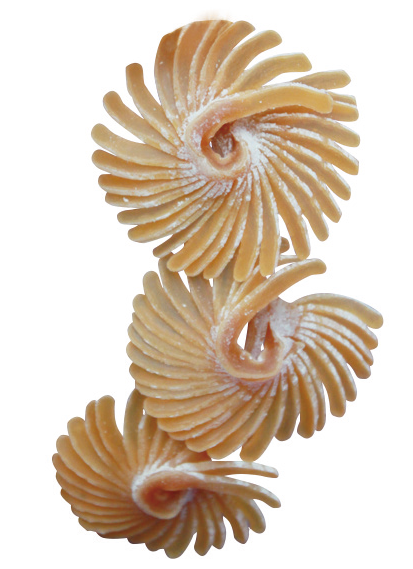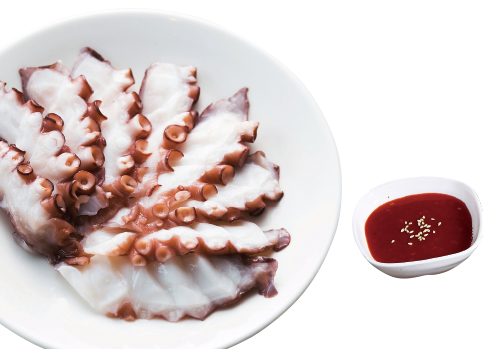Octopus has long been a prized seafood served only on special occasions, such as ancestralrites or banquets. But thanks to the ever-increasing globalization of food supply chains,octopus is found on dinner tables more and more frequently and the range of dishesstarring these mysterious creatures of the deep sea has grown more diverse nowadays.
Pre-cut samgyeopsal is being grilled on a hot gridiron. Charcoal-grilled, the pork belly delicacy is more flavorful and lessfatty than pan-fried samgyeopsal.
What is the best way to cook octopus, that fascinating and nutritious mollusk of the deepsea? Everything about its flavor and visual appeal seems to depend on how it is boiled.Even for a fried dish, it has to be boiled first. A successful boiling guarantees the taste ofall manner of octopus dishes.
It Takes Some Effort
Before boiling an octopus, one has to wash it well. Its slimy body has to be rubbed all over withsalt and thoroughly cleaned, especially the rows of powerful suction cups on the underside of itstentacles. But as too much rubbing with rough salt might abrade the skin and make the meat salty,some suggest rubbing it with sugar or flour instead.
In southern European countries, such as Spain, Portugal, or Greece, another step is customarybefore boiling. The octopus is whirled in an “octopus tumbler” which looks like a washing machine.Or it is beaten all over with a meat mallet. People living along the Greek coast even used to beatoctopuses against rocks to tenderize their meat.
In Korea, radish is commonly used when boiling octopus in order to soften it. Its whole body isrubbed and patted with grated radish, then boiled with more radish. The radish juice helps soften theoctopus meat, and also neutralizes the fishy smell.
Boiling octopus with dried persimmon is said to have the same effect. Whereas in Japan, radish isadded along with green tea leaves and red beans, in Italy octopus gets boiled with wine corks. Driedpersimmon, green tea, red beans, and residual wine in the cork stopper all have tannin in common,so tannin appears to work some magic on octopus meat.
There are more than 300 kinds of octopuses living in the five oceans. Among them, only two kindsare caught along the Korean coast: the small chammuneo (Octopus vulgaris) and the large daemuneo(Enteroctopus dofleini), also known as the giant Pacific octopus. Both turn red when dried, sothey are called pimuneo, meaning “blood octopus,” whereas those that are skinned and dried arecalled baekmuneo, “white octopus.”
The giant octopuses, caught in the deep East Sea, can weigh up to 50 kilograms when fully grown,and their tentacles can be as long as 3 meters or even longer. The small common octopus lives inspaces between stones in the shallow coastal waters of the South Sea: even the grown ones weighonly about 3.5 kilograms. An octopus has a large round head (actually a pocket of internal organs),a short body (which includes the brain and eyes), and eight tentacles. In Korea and Japan, the wholeoctopus is eaten, while in Mediterranean countries the head is usually cut off and thrown away.
The Exquisite ‘Blood Octopus’
When Koreans think of octopus dishes, the first thing that comes to mind is muneo sukhoe, thinslicedboiled octopus eaten dipped in a sauce of red chili paste and vinegar. For this dish, frozen octopusimported from the Philippines, Indonesia, Morocco, and China are more likely to be used thesedays as fewer and fewer octopuses are caught along the Korean coast, and prices have risen as aresult. Since it’s hard to farm octopus, all imported octopuses are caught at sea.
In North Gyeongsang Province, a small octopus is boiled and served whole for banquets or ancestralrites. In Andong, an old town in this province known for its yangban aristocratic traditions, octopushas long been considered the most exquisite of foods; at ancestral rites or at formal dinners, notable should lack octopus to serve the guests. There is only one warning, an old wisdom, to avoid anupset stomach: do not eat gosari (fiddlehead fern, Pteridium aquilinum) and octopus together whenpartaking of sacrificial food from ritual tables.

Muneojo cut in the shape of chrysanthemums by Seo Yong-gi, a master artisan oftraditional ceremonial food of South Jeolla Province. Dried octopus cut in variousdecorative shapes are displayed on the ceremonial tables of ancestral rites.
There is a tradition of cutting a large dried octopus in various decorative shapes for ceremonialuse, which is called muneojo. The dried octopus is put in a jar for a while to be softened, and then cutinto exquisite shapes, such as a chrysanthemum or a peacock, with a craft knife. Traditionally, thework was done by male members of the family ahead of memorial rites. Nowadays, however, this israrely seen.
In Gyeongsang and Jeolla provinces, dried octopus pieces are addedto enrich the flavor of the clear soup served at ancestral rites. Octopus isalso a choice ingredient for the porridge that mothers are fed after givingbirth. Porridge cooked with soaked dried octopus and jujube is saidto help mothers recover more quickly from childbirth.
The octopus porridge of Jeju Island is touted as a stamina food forthehaenyeo, the island’s famed female divers. First, well-soaked rice isstir-fried in a pan, and fresh octopus, pounded in a mortar beforehand, isadded and let to simmer. Then the octopus is taken out and shredded beforebeing returned to the pot to boil more. Its red skin dyes the porridge pink, and themeat is very tender. In Yeosu, a port city in South Jeolla Province, dried octopusis first washed carefully and soaked in lukewarm water for two hours, marinatedovernight with several ingredients, and then steamed. Locals regard this steamed octopusas one of the finest octopus dishes around.
There are also other dishes, such as muneo hoemuchim, boiled and thin-sliced octopus mixedwith cucumber and other ingredients; and muneo jorim, boiled and thin-sliced octopus simmereddown in Japanese-style soy sauce.
At Pulperia Ezequiel, a restaurant in the small town of Melide in the Spanish province Galicia,Korean guests are not infrequently found. They enter the restaurant on tired legs, lugging largebackpacks on an epic walk. They are modern-day pilgrims on the Road to Santiago de Compostela.Almost as soon as they arrive, they shout their order, “Pulpo (octopus), please!” They are ordering aSpanish dish similar to Korean octopus salad, the boiled and thin-sliced octopus mixed with olive oiland salt and sprinkled with a little spicy, red paprika.
In Gyeongsang and Jeolla provinces, dried octopus pieces are added to enrich the fl avor ofthe clear beef soup served at ancestral rites. octopus is also a choice ingredient for the porridgethat mothers are fed after giving birth … the octopus porridge of Jeju Island is touted asa stamina food for the haenyeo, the island’s famed female divers.
Various Medicinal Effects
Like all good food ingredients, octopus is also taken for medicinal effects. As a folk remedy, octopusink was used to help ease hemorrhoids, and water boiled with octopus to ease hives and frostbite.The water was also supposed to cure a stomach upset from eating too much beef.
Recently, octopus has garnered more attention due to the taurine it contains. Taurine, a kind ofamino acid, is known to be effective in preventing blood vessel disease and Alzheimer’s. The whitepowder on dried octopus and squid is taurine, and octopus has the highest taurine content among allmollusks.
Famous Octopus Restaurants

Muneo sukhoe, boiled and thin-sliced octopus eaten with a sauce of red chili pasteand vinegar, is the favorite octopus dish of most Koreans.
In 1955, the Yeongdong Line was opened to connect the ports of Gangwon Province and the inlandregions of North Gyeongsang Province. Then, octopus caught in the East Sea and boiled came to bedelivered by train across the mountainous countryside to the terminal station in Yeongju. Enrouteto delivery in the ambient temperature of a slow train, the boiled octopus matured and gained moreflavor. That’s probably the reason for the assertion that octopus eaten in Yeongju is especially tasty.With refrigerated distribution being the norm today, fresh octopus caught in the East Sea is deliveredunprocessed to its destination, where it is boiled and then matured for a while before selling. Theboiled octopus of Mukho Octopus House at Yeongju Market is renowned and highly sought after.
The octopus salad of the seafood restaurant Sanho in Sinsa-dong, Seoul, is known for its tendernessand fresh scent. Fresh octopus delivered from Masan, a southern port city, is boiled in a pressurecooker for 10 minutes, and then boiled again in an ordinary pot until tender.
Adding green teapowder, finely grated radish, and some of its inner organs into the boiling water is among the chef’ssecrets.
The octopus salad of Goraebul, a restaurant in Yeoksam-dong, Seoul, is known for its special wayof cooking: the octopus is only blanched, or parboiled. The meat under the cooked skin remains rawand leaves a fresh, briny aftertaste. While being boiled in water with kelpand radish, the octopus is put in and taken out several timesto gradually cook the skin only. The restaurant ownerexplains that they use octopus delivered fromYeongdeok, an eastern coastal city inNorth Gyeongsang Province, whichis famous for large snow crabsas well.